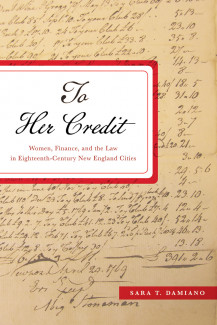
Johns Hopkins UniversityEst. 1876
America’s First Research University
Now Browsing:
Of Nouns and Verbs: Researching Women, Finance, and Law in Early America

He collected. They paid. She sued.
Works of history routinely contain phrases like these. When I began studying women’s legal activities in eighteenth-century New England, I too wrote sentences with these sorts of verbs—active, yet simultaneously vague.
I chose these words because they aligned with how I then read court records. In places like colonial Boston, MA and Newport, RI, economic networks hinged on personal borrowing and lending, and the county courts were a key arena for enforcing financial obligations. Among the hundreds of cases handled per quarterly or semi-annual term, more than three-quarters concerned debts. The vast majority of these were routine and uncontested. In such debt suits, lawyers and court clerks tracked financial obligations and legal actions, and so they largely produced skeletal, formulaic records. During my earliest forays into historical research, I breezed past these debt suits. I looked instead for the rare bulging files that, I then thought, yielded more interesting stories.
Over time, I became more curious about what I and other historians meant when, echoing the language of our sources, we used seemingly straightforward verbs. How, precisely, did one go about collecting a debt in early America? What were the practical mechanics of paying one’s creditor? How did one sue or respond to a lawsuit? And, if I attended to the eighteenth-century people who in fact carried out these activities, how could that change our understanding of early America?
In order to answer these questions, I needed to develop new strategies for reading legal records. Such methods became essential to the research and writing of my book, To Her Credit: Women, Finance, and the Law in Eighteenth-Century New England Cities.
Over time, I realized that terse, legalistic phrases bespoke complex negotiations occurring outside the courtroom. Creditors’ legal filings, for example, consistently noted that they had “often requested” payment, and that debtors had “always refused” to settle. Drafted by lawyers, such phrasing established debtors’ failure to meet their contractual obligations. Yet, once I began linking such language to details from other, well-documented lawsuits, I began to view these ubiquitous phrases as windows onto women’s extensive labor outside of court.

Behind lawyers’ insistence that creditors had “often requested” payment lay stories of women hatching financial plans, travelling through their communities and regions, and confronting others. One of these women was Margaret Fuller, an unmarried woman from Providence, Rhode Island. In February of 1730, Fuller loaned the moderate sum of six pounds to a Newport mason, Thomas Howes.
Howes’s debt came due in May of 1730, and Fuller took an overnight trip to collect. She hired a boatman to carry her down the Providence River and across Narragansett Bay. Upon arriving in Newport, Fuller demanded payment from Howes. Lacking cash, Howes offered a barrel of sugar, which Fuller accepted. She and her boatman picked up the barrel from a tavern the following day.
While in Newport, Fuller travelled the city on foot, making several social and business calls. During each, she informed other men and women of her arrangement with Howes. When Fuller later decided that the sugar was insufficient payment and sued Howes, these Newport residents testified about her activities.
Margaret Fuller was part of a larger group of female creditors. In eighteenth-century Boston and Newport, women comprised roughly ten percent of litigants in debt suits. More than two-thirds of such women were creditors. Equally significant, debt suits reflected only a tiny fraction of the borrowing and lending that occurred in these cities. Margaret Fuller’s journey as revealed in witness depositions, then, reflected one version of women’s very routine efforts to collect from debtors.
Such financial labor by women becomes even more consequential when recognizing port cities’ imbalanced gender ratios. Seafaring and warfare drew urban men away from home and, in many cases, claimed their lives. By the eve of the Revolution, cities possessed roughly 5 adult women for every 4 adult men. Women formally headed 1 in 5 households, and this figure did not even reflect men’s temporary absences. Day-to-day, urban women sustained financial networks and protected their families’ property.
When studying early American women and courts, we are often drawn toward matters of sex or slander. Such exceptional, captivating cases can indeed tell us much about women’s status. Yet, more so than sex crimes or slander suits, financial transactions and debt litigation were the stuff of everyday life. As To Her Credit shows, records of debt suits offer countless glimpses into women’s movement, speech, and skill. When we assemble such often-fragmentary evidence, we can see financial relationships shaped power dynamics between women and men. Equally significant, we can see that women’s labor undergirded the development of financial and legal institutions.
Order To Her Credit: Women, Finance, and the Law in Eighteenth-Century New England Cities at the following link:
Sara T. Damiano is an assistant professor of history at Texas State University. She is the author of To Her Credit: Women, Finance, and the Law in Eighteenth-Century New England Cities.

Works of history routinely contain phrases like these. When I began studying women’s legal activities in eighteenth-century New England, I too wrote sentences with these sorts of verbs—active, yet simultaneously vague.
I chose these words because they aligned with how I then read court records. In places like colonial Boston, MA and Newport, RI, economic networks hinged on personal borrowing and lending, and the county courts were a key arena for enforcing financial obligations. Among the hundreds of cases handled per quarterly or semi-annual term, more than three-quarters concerned debts. The vast majority of these were routine and uncontested. In such debt suits, lawyers and court clerks tracked financial obligations and legal actions, and so they largely produced skeletal, formulaic records. During my earliest forays into historical research, I breezed past these debt suits. I looked instead for the rare bulging files that, I then thought, yielded more interesting stories.
Over time, I became more curious about what I and other historians meant when, echoing the language of our sources, we used seemingly straightforward verbs. How, precisely, did one go about collecting a debt in early America? What were the practical mechanics of paying one’s creditor? How did one sue or respond to a lawsuit? And, if I attended to the eighteenth-century people who in fact carried out these activities, how could that change our understanding of early America?
In order to answer these questions, I needed to develop new strategies for reading legal records. Such methods became essential to the research and writing of my book, To Her Credit: Women, Finance, and the Law in Eighteenth-Century New England Cities.
Over time, I realized that terse, legalistic phrases bespoke complex negotiations occurring outside the courtroom. Creditors’ legal filings, for example, consistently noted that they had “often requested” payment, and that debtors had “always refused” to settle. Drafted by lawyers, such phrasing established debtors’ failure to meet their contractual obligations. Yet, once I began linking such language to details from other, well-documented lawsuits, I began to view these ubiquitous phrases as windows onto women’s extensive labor outside of court.

Behind lawyers’ insistence that creditors had “often requested” payment lay stories of women hatching financial plans, travelling through their communities and regions, and confronting others. One of these women was Margaret Fuller, an unmarried woman from Providence, Rhode Island. In February of 1730, Fuller loaned the moderate sum of six pounds to a Newport mason, Thomas Howes.
Howes’s debt came due in May of 1730, and Fuller took an overnight trip to collect. She hired a boatman to carry her down the Providence River and across Narragansett Bay. Upon arriving in Newport, Fuller demanded payment from Howes. Lacking cash, Howes offered a barrel of sugar, which Fuller accepted. She and her boatman picked up the barrel from a tavern the following day.
While in Newport, Fuller travelled the city on foot, making several social and business calls. During each, she informed other men and women of her arrangement with Howes. When Fuller later decided that the sugar was insufficient payment and sued Howes, these Newport residents testified about her activities.
Margaret Fuller was part of a larger group of female creditors. In eighteenth-century Boston and Newport, women comprised roughly ten percent of litigants in debt suits. More than two-thirds of such women were creditors. Equally significant, debt suits reflected only a tiny fraction of the borrowing and lending that occurred in these cities. Margaret Fuller’s journey as revealed in witness depositions, then, reflected one version of women’s very routine efforts to collect from debtors.
Such financial labor by women becomes even more consequential when recognizing port cities’ imbalanced gender ratios. Seafaring and warfare drew urban men away from home and, in many cases, claimed their lives. By the eve of the Revolution, cities possessed roughly 5 adult women for every 4 adult men. Women formally headed 1 in 5 households, and this figure did not even reflect men’s temporary absences. Day-to-day, urban women sustained financial networks and protected their families’ property.
When studying early American women and courts, we are often drawn toward matters of sex or slander. Such exceptional, captivating cases can indeed tell us much about women’s status. Yet, more so than sex crimes or slander suits, financial transactions and debt litigation were the stuff of everyday life. As To Her Credit shows, records of debt suits offer countless glimpses into women’s movement, speech, and skill. When we assemble such often-fragmentary evidence, we can see financial relationships shaped power dynamics between women and men. Equally significant, we can see that women’s labor undergirded the development of financial and legal institutions.
Order To Her Credit: Women, Finance, and the Law in Eighteenth-Century New England Cities at the following link:
Sara T. Damiano is an assistant professor of history at Texas State University. She is the author of To Her Credit: Women, Finance, and the Law in Eighteenth-Century New England Cities.

Login to View & Leave Comments
Login to View & Leave Comments


